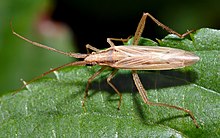Stenodema laevigata
| Stenodema laevigata | ||||||||||||
|---|---|---|---|---|---|---|---|---|---|---|---|---|

Stenodema laevigata , green form |
||||||||||||
| Systematics | ||||||||||||
|
||||||||||||
| Scientific name | ||||||||||||
| Stenodema laevigata | ||||||||||||
| Linnaeus , 1758 |
Stenodema laevigata is a bug (Heteroptera) from the family of soft bugs (Miridae). Because of its preference for grasslands and sweet grasses (Poaceae) as food, it belongs to the group of stenodemini commonly known as "grass bugs".
Distribution and habitats
This bug occurs all over Europe as far as North Africa. Their distribution area extends eastwards across Asia Minor and the Caucasus to northern China. It prefers to colonize grass-rich biotopes . It lives in both open and shady locations as well as in deciduous and coniferous stands.
Features and way of life
Stenodema laevigata is an elongated bug with body lengths between 7.6 and 9.2 millimeters. Their coloring shows a color change, characteristic of the genus Stenodema , of green, brown and yellow tones in adaptation to the colors that predominate in their surroundings. The different stages of coloration of S. laevigata range from light yellow to ocher and green to finally brown in autumn. The hibernating females turn green in spring after they have eaten for the first time. There is a longitudinal furrow between the animals' eyes; the scutellum has numerous point pits. It differs from the very similar Stenodema calcarata by the lack of thorns on the hind leg.
The Stenodema laevigata feeds exclusively on plant juices (phytophag) of the sweet grasses especially of the genera Alopecurus , Dactylis , Festuca , Holcus , Agrostis , Deschampsia , Triticum , Secale and others. The larvae first suckle on the vegetative parts such as leaves and stalks. Later they switch to the inflorescences and suckle the immature seeds like the adults.
The hemimetabolic bug forms one generation a year. Wintering takes place in the adult stage in dry soil litter or in grass clusters. The females lay their eggs on the inflorescences of the host grasses between June and July. New adults appear from mid-June to late July. Copulations do not take place before wintering, but only in the following year in May.
literature
- Ekkehard Wachmann , Albert Melber, Jürgen Deckert: Bugs Volume 2: Cimicomorpha: Microphysidae (lichen bugs) , Miridae (soft bugs) , Goecke & Evers, Keltern, ISBN 3-931-37457-2
- E. Wagner: Heteroptera Hemiptera. - In: Brohmer, P., P. Ehrmann & G. Ulmer (eds.): Die Tierwelt Mitteleuropas. IV, 3 (Xa). - Leipzig 1959, 173 pp.
- E. Security guard: Bugs - get to know, watch. Neumann-Neudamm 1989, ISBN 3-7888-0554-4

